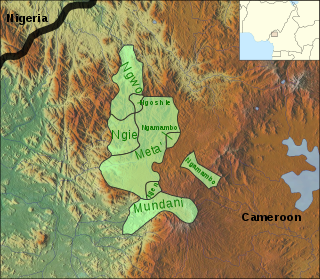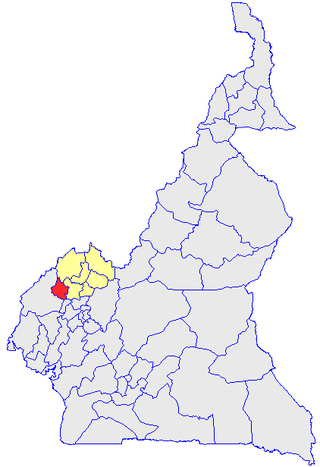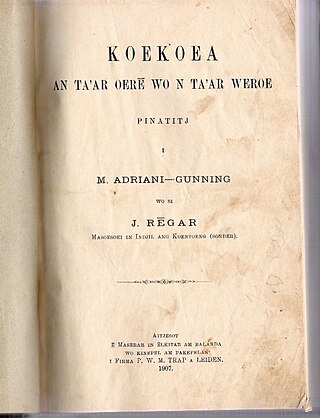Related Research Articles
OLAC, the Open Language Archives Community, is an initiative to create a unified means of searching online databases of language resources for linguistic research. The information about resources is stored in XML format for easy searching. OLAC was founded in 2000, and is hosted at the Linguistic Data Consortium webserver at the University of Pennsylvania.

Fox is an Algonquian language, spoken by a thousand Meskwaki, Sauk, and Kickapoo in various locations in the Midwestern United States and in northern Mexico.
Aghu, or Central Awyu, is a Papuan language of South Papua, Indonesia. It may actually be two languages, depending on one's criteria for a 'language'. The two varieties are: Mappi River Awyu (Aghu) and Pasue River Awyu.
Huave is a language isolate spoken by the indigenous Huave people on the Pacific coast of the Mexican state of Oaxaca. The language is spoken in four villages on the Isthmus of Tehuantepec, in the southeast of the state, by around 20,000 people.
Cocama (Kokáma) is a language spoken by thousands of people in western South America. It is spoken along the banks of the Northeastern lower Ucayali, lower Marañón, and Huallaga rivers and in neighboring areas of Brazil and an isolated area in Colombia. There are three dialects. The robust dialect is known as Cocama, Kokama, Kukama-Kukamiria, Ucayali, Xibitaoan, Huallaga, Pampadeque, and Pandequebo. By 1999, Cocamilla (Kokamíya) was moribund, being only spoken by people over 40.
Bure, also known as Bubbure, is an Afro-Asiatic language belonging to the Bole-Tangale group of the West branch of the Chadic family. It is spoken in northern Nigeria in the village of Bure and in some small settlements nearby. The language is used mostly by a very few speakers, of great-grandparental generation. Except for Hausa, which is lingua franca in the area, Bure is surrounded by other Chadic languages such as Gera, Giiwo and Deno . Compared to other languages of the same group, the endangerment of Bure is by far the most critical.

Carolina Algonquian was an Algonquian language of the Eastern Algonquian subgroup formerly spoken in North Carolina, United States. Carolina Algonquian was formerly spoken by Secotan, Chowanoke and Weapemeoc peoples.
Barbareño is one of the Chumashan languages, a group of Native American languages spoken almost exclusively in the area of Santa Barbara, California. The closely-related Ineseño may have been a dialect of the same language. A dialect of the Barbareño language was also "spoken at San Emigdio near Buena Vista Lake" in the southern Central Valley. This dialect, called Emigdiano, "was heavily influenced by Buena Vista Yokuts." Barbareño lost its last known native speaker in 1965 with the death of Mary Yee. Both Barbareño and Ineseño are currently undergoing processes of language revitalization.
The Southwest Grassfields, traditionally called Western Momo when considered part of the Momo group or when Momo is included in Grassfields, are a small branch of the Southern Bantoid languages spoken in the Western grassfields of Cameroon.

The Momo languages are a group of Grassfields languages spoken in the Western High Plateau of Cameroon.

Momo is a department of Northwest Province in Cameroon. The department covers an area of 1792 km2 and as of 2005 had a total population of 138,693. It is the ethnic home of the Widikum People. The capital of the department lies at Mbengwi.
Luvale is a Bantu language spoken by the Lovale people of Angola and Zambia. It is recognized as a regional language for educational and administrative purposes in Zambia, where about 168,000 people speak it as of 2006. Luvale uses a modified form of the latin alphabet in its written form.
Mituku is a Bantu language of the Democratic Republic of the Congo. The Mokpá dialect is distinct.

Tontemboan is an Austronesian language, of northern Sulawesi, Indonesia. It is a Minahasan language, a sub-group of the Philippine languages.
Chiapas Zoque is a dialect cluster of Zoquean languages indigenous to southern Mexico. The three varieties with ISO codes, Francisco León, Copainalá, and Rayón, are named after the towns they are spoken in, though residents of Francisco León were relocated after their town was buried in the eruption of El Chichón Volcano in 1982. Francisco León and Copainalá are 83% mutually intelligible according to Ethnologue.
Aimele, or Kware, is a Papuan language of Papua New Guinea.
Tututni, also known as Upper Coquille, (Lower) Rogue River and Nuu-wee-ya, is an Athabaskan language once spoken by three Tututni tribes: Tututni tribe, Coquille tribe, and Chasta Costa tribe who are part of the Rogue River Indian peoples of southwestern Oregon. In 2006 students at Linfield College participated in a project to "revitalize the language." It is one of the four languages belonging to the Oregon Athabaskan cluster of the Pacific Coast Athabaskan languages.
Ixtlán Zapotec is a Zapotec dialect cluster of Oaxaca, Mexico.
The "Momo Challenge" was a hoax and an Internet urban legend that was rumored to spread through social media and other outlets. It was reported that children and adolescents were being enticed by a user named Momo to perform a series of dangerous tasks including violent attacks, self-harm, harming others, and suicide. Despite claims that the phenomenon had reached worldwide proportions in July 2018, the number of actual complaints was relatively small and no law enforcement agency has confirmed that anyone was harmed as a direct result of it.
Achama is a location in Cameroon located in the department of Momo in the Northwest Region. It is part of the commune of Widikum-Boffe and consists of two villages, Lower Achama and Upper Achama.
References
- ↑ Menka at Ethnologue (18th ed., 2015) (subscription required)
- ↑ "OLAC resources in and about the Menka language". OLAC: Open Language Archives Community. University of Pennsylvania. Retrieved 20 September 2021.
- ↑ "Menka". Endangered Languages Project. University of Hawaii. Retrieved 20 September 2021.